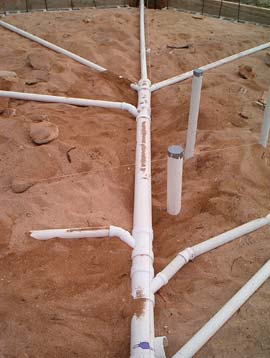- WELCOME
-
SLEEP
-
REALTY & BUSINESS
-
THINGS TO DO
-
EAT
- SPECIAL
- KEEP IN TOUCH
- SAVE 10%
|
|
Rough Plumbing Part 1: The Drain Pipes
The back fill has been placed within the foundation walls up to the predetermined grade and well compacted. Anguilla plumbing material is purchased and we are ready to start burying some pipe.
Unlike many other parts of the world where copper, galvanized, cast iron, ABS and other materials are used for plumbing, the Caribbean region generally uses PVC (to prevent corrosion). Anguilla plumbers are no exception.
Finding a competent plumber is one of the most important exercises when building. It is the circulation system of your house. Furthermore, most of the plumbing is buried under or imbedded in concrete. Corrections and repairs can be very time consuming and expensive so you want to avoid them at all cost.
Mr. Vanterpool is one of the best and has worked extensively in both Anguilla and St-Thomas.
All his experience will be required in getting the job done right. Let's break down our Anguilla plumbing job into more manageable steps.
The Drain Pipes (No Pressure Pipes)
These are larger diameter pipes that are used for drainage. This includes water from the toilets, showers, sinks. These drainage pipes also include all the pipes that lead to the cistern. They make their way from roofs and terraces where rain water is captured all the way down to the cistern.
The Water Supply Pipes (Pressure Pipes)
These are generally smaller diameter pipe that draw from the cistern and deliver water to various parts of the house. This includes kitchens, bathrooms, swimming pool, gardening hose bibs, etc.
Pressure pipes are installed above the reinforcing steel work for the slab, but within the slab concrete itself. They also run inside of concrete block walls and columns to the final destination.
We will come back to this segment of the plumbing job after the steel reinforcement is placed for the slab.

The plumbing plans are reviewed and the trenching begins. All the straight pipes are laid and glued together with a variety of fittings, helping to attain desired directions, angles and slopes.
There are pipes running all over the place, to the cistern to the septic tank, to the sinks, showers and to the toilets.
All drain pipes that will continue above slab height, which is to say to the first and second levels, are put in place with pipe stubs extending beyond the slab height. These stubs are capped to keep debris out.
At a later stage coupling will be used to extend the pipes further up towards their final destination.
Mr. Vanterpool Hard At Work

The most important consideration? Make sure that all your drainage pipes have the necessary slope to properly send all effluent to its final destination efficiently.

No slope or a counter-slope will cause you a lot of problems and grief. Counter-slopes (when the pipe is sloping in the wrong direction) and sagging in pipes cause stagnation, sedimentation and eventual blockages.
Having the correct slope also helps the waste get to the end of the pipe with the least amount of water. With today's toilets flushing only 1 gallon, the slope of the pipe has to be just right. Too much or too little slope is not good.
Because we have a very intricate roof and terrace design as well as two cisterns, we had to use quite a few downspouts to collect the rainwater and send it to the right location.

If you are building close to the sea like we are, all these downspouts need to have a method of shutting them off prior to a hurricane or severe tropical storm. This is because the winds will drive the saltwater into the air, onto your roof and eventually into your cistern, tainting your water supply.
The method typically used is to install valves under the eaves or at the base of each downspout to divert the water when necessary. This system can prove to be unsightly and take away from your roof line design.
Mike decided to use a centralized system where all the downspouts were divided into two areas. The downspouts from each of these areas converged to one location and a valve will be placed on each convergence point prior to reaching the cistern. We required more pipe with larger diameters but in the end we got rid of a lot of unsightly valves that have to be individually turned on and off from high ladders and the like.

All the work is checked and inspected for location, slope, and proper gluing of fittings. The system is ready to be buried. Special attention must be taken to make sure nothing is damaged when the backfill is placed over the pipes.
First though...
Time to call in Dynamite Dennis Harrigan, the exterminator to do a treatment of the area we backfilled within the footprint of the house. The spraying is done just before the moisture barrier is laid down in preparation for the steelwork. The balance of the plumbing and all sub-slab electrical installations will be performed after that.

We made sure that all the trenching, plumbing installation work and backfilling was done prior to calling in the exterminator.
Why?
We have grown fond of "Blue Eyes" whom Mike has affectionately re-named "Sinatra" and want to keep this friendly and professional Anguilla plumber healthy and safe.
Now if only he could sing as well as he does plumbing.

Tranquility Beach
(Luxury Hotel & Residences)

Long Bay Villas:
The Ultra-Luxury Villas
Sky, Sea & Sand

Santosha Villa Estate:
Anguilla's Most Sophisticated
Ultra-Luxury Villa
Facebook Comments
Have your say about what you just read! Leave a comment in the box below.